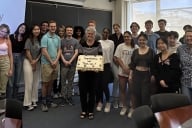You have /5 articles left.
Sign up for a free account or log in.
To evoke the highest principle of copyright law, the balance between incentive and innovation, is copyright’s most important lesson. Its appearance in the Cambridge v. Patton decision therefore readily caught my attention. The Court, which reversed the district court that had favored Georgia State, used that principle as a guiding concept in evaluating each of the four fair use statutory factors, plus the new one that has emerged in case law since the promulgation of the Copyright Act of 1976: transformative use. In critiquing the district court’s opinion, the appellate court urged that these factors not be thought of as a “check list,” but rather evaluated holistically.
To this overarching principle about copyright let us add that of not-for-profit higher education: public service. If we do, then when it comes to the “kind of use” factor, the appellate court might be just as guilty as they alleged the district court to have been in taking a “check list” approach to the factors. Both courts checked the box favorably with regard to educational use, but, in my opinion, did not give that factor adequate weight, especially in light of their “holistic” approach.
Not for profit organizations in general – charitable organizations, organized religion and education – get tax breaks because they are in service not of individual profit in the bold capitalist tradition of American business and upward mobility but for the society at large. Graduation speeches and other inspirational speakers might still invoke the notion of service beyond the self, but as a historian I would venture that John Kennedy’s “ask not …” was its last resonate invocation, and Lyndon Johnson’s “Great Society” the deed. Since about the election of Nixon, the United States, fueled by corporate interests, has moved not in an exact straight line but in an overall progressive march away from notions of community and service ever-increasingly toward individual rights, albeit largely organized in the form of the for-profit corporations.
It is not a wonder, then, that the appeal court glossed over this factor. Perhaps they are stuck in a 1976 version of higher education? Probably at its post World War II height, higher education rode high in those years of the G.I. Bill, the Higher Education Act, and generous government research grants. State university systems: think Berkeley, Binghamton and Birmingham as models along with the Big 10, opened doors to generations of people whose parents might have been lucky to graduate high school. Private colleges had tuition rates affordable to the middle class.
Dear Judges of the 11th Circuit Appeal Court Panel, a lot has changed since then. Assuming you have children who attend college, you reply, “I know! Look at this tuition I am paying for my son or daughter!” That is the iceberg tip of the story. The price reflects the costs that have risen at the same level as health care in the last 50 years. Were this a book not a blog, I could regale you with spreadsheets expenses for laboratories, student services, buildings, and information technologies. But as a blog, the point is: Higher education costs EVERYONE more than it did in 1976. And most people are in less of a position to afford it now than they were then. Moreover, and this is key: you may not be familiar with the costs of scholarly publishing. Almost unique to higher education, these costs not only cripple the institutions – given the needs of academic libraries to serve the institution’s missions – but also the students, who have been socialized to pay exorbitant rates for textbooks and other academic published materials.
Tomes have been written on the need to reform scholarly publishing, including in this blog, and it is worth repeating: higher education MUST reform itself on this matter. That said, Dear Justices, using your own advice to think of fair use holistically, may I suggest that this analysis not be hermetically sealed into itself on copyright alone but take into account higher education public policy? It cannot be reduced to a checked box. It must be seen in its fullest dimensions. And its principle of public service deserves just as much, if not more, consideration than the publishers who have been taking advantage of it and its constituents for some time now. View fair use in the context of innovation and incentive holistically! Take a look at the extraordinary expansive scope, terms and damages of copyright before micromanaging fair use. And give not-for-profit higher education more weight on the scales of copyright justice.






